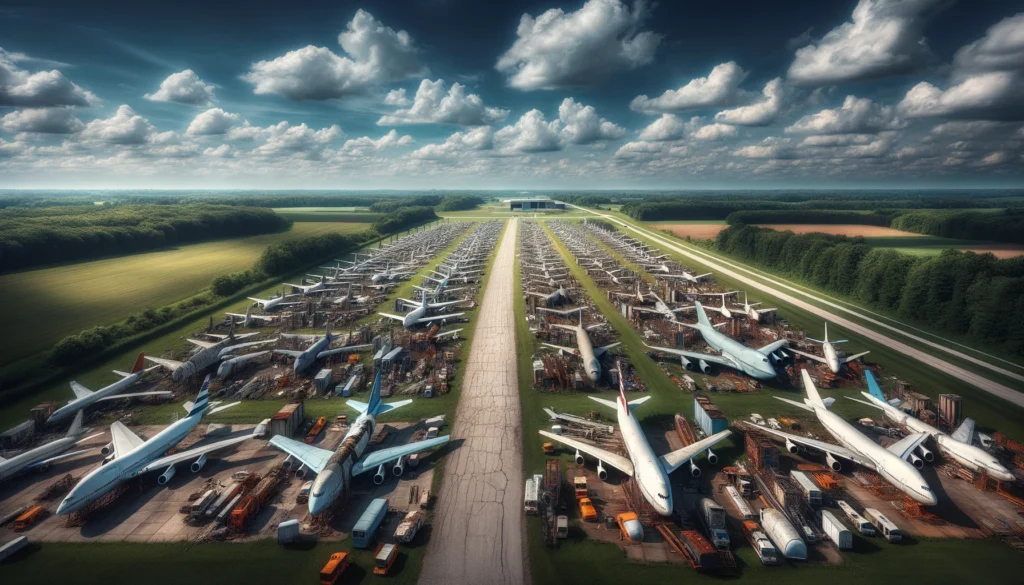The image of Airline Graveyards or Airplane Graveyards is a complex one; on the one hand, it is accompanied by feelings of wonder and fascination or even a direct association with ancient graveyards for some people, but at the same time, it may provoke mixed feelings.
Such Graveyards or Boneyards are not just storage places, they are Living Exhibitions with Respective Stories Outlined. Therefore, aviation history and legacy are being preserved.
Let us take this journey together through some of those Most Legendary Airline Graveyards from the California and Arizona deserts to the suburbs of Bangkok and all across the globe.
These sites not only act as a place to keep the memory alive but also are a classroom for past and present aviation.
This is the passage where we follow through the most recognized graveyards by revealing their stories, their uniqueness, and the stories of the aircraft they keep.
The 309th Aerospace Maintenance and Regeneration Group (AMARG) is based out of Tucson, Arizona

Among the great deserts of Arizona, the 309th Aerospace Maintenance and Regeneration Group (AMARG) represents an intriguing scene. Affectionately called “The Airline Graveyard,” it is the biggest aircraft storage facility globally.
Following World War II, AMARG became indispensable for Air Force aircraft usage, starting from Storage and Maintenance & going up to Regeneration and Recycling.
History: AMARG, which was started in 1946, has now become the burial place for over 4,400 Airplanes. Its roots are found in the years after the war when it was more evident that there was surplus Military Aircraft’s needed to be stored.
Now, it serves as a home to an incredible number of Aircraft, from Historic Fighters to Huge Freighters and even Shuttle Vehicles that have completed their Space Missions.
If we talk about the Notable Aircraft Among its assortment, we get icons like the Boeing B-52 Stratofortress, the F-14 Tomcat, and the Boeing 707 Air Force One. Every plane has its own story, be it from Dog Fights to Humanitarian Aid Missions around the world.
Address:309th Aerospace Maintenance and Regeneration Group, Tucson, AZ, USA
Teruel Airport, Spain

Europe’s answer to Aerospace Maintenance and Regeneration Group is the Teruel Airport, One of the Largest Aircraft Storage And Recycling Facilities on the Continent. Its arid climate enables this site to be perfect for aircraft preservation.
History: Inaugurated in 2013, the airport of Teruel immediately took on a prominent role in aviation as a service provider of storage, repair, and disassembly. Being able to contain many airplanes and its strategic position in Spain have made it chosen by many airlines from all over the world to store their fleets, especially during the COVID-19 pandemic.
If we talk about Notable Aircraft, the Teruel is the home of many Commercial Airliners ranging from Airbus A380s, and Boeing 747sp to many others waiting either for being returned to service or recycled.
Address: Teruel Airport, Teruel, Spain
Alice Springs Airport, the Northern Territory, Australia
Alice Springs Airport has become one of the strategic aircraft storage facilities, being prominent during the Global Downturn of Air Travel due to the COVID-19 pandemic.

History: The speed of development was intensified by the pandemic, creating more demand for this type of cemetery even in traditional markets. Its arid climate is quite suitable for long-term preservation of stored aircraft.
If we talk about the Notable Aircraft, the range of aircraft at the airport has been from major carriers such as Qantas and Singapore Air to models ranging from the Boeing 777 to the Airbus A320.
Address: Alice Springs Airport in the Northern Territory, Australia
Airplane Graveyard Roswell New Mexico: The Intersection of Aviation and Suspense

The Roswell Airplane Graveyard – located near the location of the well-known incident of the flying military ballon that happened back in 1947, stands halfway between the history of aviation and the world of popular culture. This one-time base of the Walker Air Force transformed into an airplane boneyard with a blend of interesting historical background and intriguing atmosphere of Roswell’s UFO mystery.
For the USA pop culture, the city of Roswell deserves a special place, especially after the peculiar 1947 Roswell UFO event. The mysterious airplane graveyard gives the area yet another mystical dimension, drawing people curious not only about aviation but also about the rumors surrounding UFOs and extraterrestrial beings.
As for the graveyard, which is a common practice in aviation management, something new is hidden in the proximity such as museums, festivals, and attractions to explore the unknown.
Address: Lincoln County, New Mexico, USA
California’s Aviation Giants Victorville and Mojave

Victorville Airplane Graveyard California, officially known as Southern California Logistics Airport. Located in the Mojave Desert, this place uses an arid atmosphere to store planes.
Airlines accumulate their airplanes here, which are then sent for preservation, maintenance, or dismantling. This way, Victorville becomes an important link for aircraft life cycle movements.
At the edge of the field, the Mojave Air and Space Port has a dual role in acting as the final place for both commercial airplanes and aerospace models. On a large area of land, the organization’s facilities have been symbolically treated as a stop-off place for planes going from the skies to the pages of history.
Victorville Airplane Graveyard, situated in California, represents the story of a commercial airline dedicated to perpetual operation. Hangars accommodate a wide type of aircraft from small airplanes to large Boeing 747, not only detecting the peak but also the depth of demands in the airline market.
The dry climate of Victorville makes it an aircraft storage site with impeccable qualities that meet all the airline needs in line with the conditions of fleet transition.
Address: Southern California Logistics Airport, 18374 Phantom W, Victorville, CA 92394, United States
Kingman Arizona Aircraft Graveyard: An Interface of WWII Flying
The wreckage of airplanes at the Kingman Graveyard in Arizona is irreplaceable when it comes to the storied History of Military Aviation. Kingman was once a focal spot for the storage and disassembling of WWII aircraft. Today, a vision of the huge volume of war production and the peace efforts following are rendered through this.

Ohio’s Airplane Graveyard
Though Airplanes here are not as widely recognized as those in the deserts, this Ohio plane Graveyard with a variety of military and commercial aircraft remains an outstanding place.
The presence of an Aviation Museum in the Midwest makes us realize the importance of this region in aviation history and also gives a very different perspective from which the industry moves forward.
Frequently, the appeal of these exhibits grows from the multiplicity of planes, as well as each of them being the carriers of tales.
Florida’s Coastal Collection
In the SouthEast US, Florida is the location of a gravity well where commercial and military aviation history both survive. The warm and humid environment of the region poses specific conservation problems, yet few facilities focus on airplane saved storage, maintenance, and salvage.
The cemeteries represent the broader American culture and technology narrative related to the influence of Aviation on the United States.
Bangkok’s Urban Graveyard: Giants among community
The Bangkok Airplane Graveyard presents a complete detail departing from the remote stretches of the United States. Here, these very old airplanes that are no longer in service have now become makeshift Residences and playgrounds for local families. This place presents the rare convergence of aviation history and modern-day metropolitan living, representing the level of adaptation and continuing inquisitiveness of these fantastic machines.
The environmental, Cultural, and economic outcome of Airline Graveyards
Reuse of aircraft represents a vital part of the green strategy in aviation. Through facilities like those in Teruel and Mojave, tens of kilograms of airplane mass are recycled and thus, waste is reduced and sustainability maintained. Additionally, the recycled materials and parts will help in terms of monetary reuse, repair of aircraft, and creation of a circular economy within the sector.
Airline Graveyards which were first used as disposal locations for retired aircraft by operators have now drawn the attention of photographers, historians, and aviation junkies. They afford the realization of a perspective on the advancement of air travel, which shows the successes and the difficulties of the industry as well. Tours and photography displays at these places have gained increasing interest, and these travelers enjoy the beauty and serenity of these stoic reprises.

Airline Graveyards are not storage facilities, they are spirit homes that in addition to chronological context also give an insight into aviation history. When we visit these miraculous platforms, we are unable not to mention the tireless progression of technology and the ceaseless attraction of flight. These cemeteries serve both practical and symbolic functions. Firstly, they provide an adequate location for such vast “corpses’ and, at the same time, they remind us of all the airplanes we manufacture and use by mankind.
Frequently Asked Questions:
1 – What is an airplane graveyard, and why do they exist?
Airplane graveyards, another name for aircraft boneyards, are storage areas for aircraft that are no longer fit to fly. They work mainly to store, salvage, or recycle aircraft and its parts. Frequently, these facilities can be found in dry areas to avoid corrosion. Here planes can be retrieved for further disassembly, recycling, or restoration.
2 – Can tourists visit airplane graveyards?
Tourists can visit airplane graveyards. Facilities like the Pima Air & Space Museum in Tucson, AZ, and the Mojave Air and Space Port in California provide public tours that will enable visitors to view aviation history and the whole life cycle of aircraft. Nevertheless, not all graveyards are accessible to the general public, because of security and safety concerns.
3 – What is the largest aircraft boneyard in the world?
The Davis-Monthan Air Force Base in Tucson, Arizona, is home to the biggest aircraft boneyard in the world. Spreading over 2600 acres, it accommodates all retired military aircraft, which makes it a major spot for storage, preservation activities, and recycling processes.
4 – How many airplane graveyards are there in the United States?
The exact extent of airplane graveyards in the United States is unclear; estimates show about Ten to Twelve major facilities across the nation. These aircraft cemeteries provide diverse services like storing and preserving, dismantling, and recycling.
5 – Where is the famous aircraft graveyard located?
The famous aircraft cemetery, locally referred to as the Airline “Graveyard” or “boneyard,” is located within the Davis-Monthan Air Force Base in Tucson, Arizona. This is a place that is well known for its huge inventory of old military aircraft as well as for aviation history.
6- Are there any airplane graveyards open to the public?
In reality, some aircraft graveyards are indeed open to the public providing a thrilling perspective of the aircraft life cycle decommission. Prominent instances include the Pima Air and Space Museum and the Mojave Air and Spaceport. Visitors are advised to contact the site and confirm the time of visit as policies may differ from one site to another.
7 – What happens to airplanes in airplane graveyards?
Every plane coming into a graveyard will go through different processes depending on its condition. Some might be taken apart for parts that are recycled, while others may be kept for reconstruction, resold for reuse, or used in films, TV shows, and military training. Such lifecycle management is of paramount importance not only to the environment and aviation sector but to the whole.
8 – How do aircraft graveyards contribute to the aviation industry?
Aircraft Graveyards have become an indispensable part of the aviation industry as they provide a reliable source of parts and components which help the industry cut down costs and become more environment-friendly.
In addition, they provide great room for stashing aircraft that are temporarily grounded or will go for sale, so that these planes are readily available for dispatching and allocation as needed.

